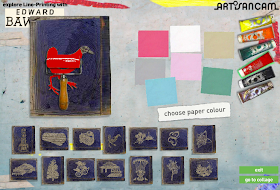 |
| Here's a way to create and learn without getting your hands messy. Learn to print linocuts like Edward Bawden or create sculptures from natural materials like Andy Goldsworthy or illustrate a children's book like Sarah Dyer. These artists and so many more demonstrate their specialized skills in videos and interactive demos where everyone is an artist. You can choose from textile arts, photography, wire sculpture, screenprinting, and dozens more materials. When completed, you can post your artworks in a gallery, print them and even email them to friends. It is fun for all ages, all brought to you by the imaginations of the people behind the site ArtisanCam in the UK. |
 |
| Learn about Edward Bawden and his Kew Gardens poster work for the London Underground. |
 |
| So I tried my hand at printing some of his linocuts by choosing an ink color, then the brayer and the paper... |
 |
| Voila! I made a print. There is an opportunity to make a collage from all of your prints, but I quickly gave up after getting the sticky-scissors-of-death and I bailed. Next I tried screen printing. |
 |
| Then I tried to make a book and draw like Sarah Dyer, but quickly learned I had to use her images to tell the story. I gave that up after I couldn't make the virtual pencil work. I think you have to be 8 years old in order to know how to write with it. |
 |
| I couldn't get past the over-muscled superheroes at this venue, but don't let it stop you from trying it. |
 |
| Been there, done this already, but I think it is a wonderful exercise and virtual introduction to making books. Think I may go on a photoshoot or make a visit to sculpturama now. This beats learning to draw from a matchbook cover which is pretty much where I began, but what they really need here is a how to balance your checkbook or how to eek out a living with potato prints right at home. |











































